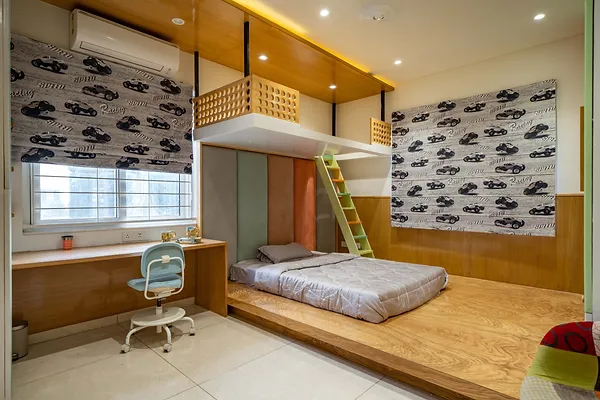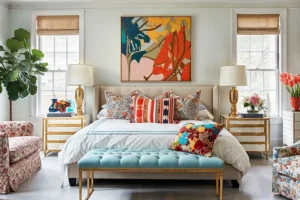Designing a kids’ bedroom is a wonderful opportunity to blend creativity with practicality. A well-designed kids’ room should be both fun and functional, providing a space that encourages play, learning, and relaxation while also offering ample storage and organization. Here are some exciting and practical ideas to help you create a space that will grow with your child and adapt to their evolving needs.
1. Themed Rooms
Themed rooms can spark your child’s imagination and create a fun environment tailored to their interests. Whether it’s a space-themed room with stars and planets, a jungle adventure with animal prints, or a fairytale kingdom with castles and dragons, choosing a theme can make decorating easier and more cohesive. Incorporate themed elements through wall decals, bedding, and furniture to create an immersive experience. Just ensure the theme can be easily updated as your child grows and their interests change.
2. Multi-Functional Furniture
Incorporate multi-functional furniture to maximize space and improve organization. Bunk beds with built-in drawers, lofted beds with desks underneath, or convertible cribs that transition into toddler beds are great options. Multi-purpose furniture helps keep the room tidy and provides extra storage for toys, books, and clothing. Look for pieces that offer versatility and can be adjusted as your child’s needs evolve.
3. Interactive Wall Features
Make the walls in your child’s room more engaging with interactive features. Chalkboard or whiteboard paint can turn a wall into a canvas for drawing and writing, encouraging creativity and learning. You can also add a magnetic wall for sticking up artwork and photos or a growth chart to track their height over the years. Interactive wall features not only enhance the room’s functionality but also provide endless entertainment.
4. Creative Storage Solutions
Storage is key in a kids’ room to keep the space organized and clutter-free. Use creative storage solutions like under-bed bins, hanging organizers, and wall-mounted shelves. Toy chests with built-in seats or bookcases with built-in drawers can serve dual purposes. Labeling bins and shelves can also help teach your child organization skills. Incorporating storage into fun elements like a playhouse or a bed with drawers can make tidying up less of a chore.
5. Colorful and Cozy Textiles
Textiles play a significant role in adding comfort and color to a child’s room. Choose bright, cheerful fabrics for curtains, bedding, and rugs to create a lively atmosphere. Layer different textures with throw pillows, blankets, and bean bags to make the room more inviting. Opt for washable and durable materials, as kids’ rooms are prone to spills and stains. Textiles are an easy and inexpensive way to refresh the room’s look and add a touch of fun.
6. Customizable Art Spaces
Create a dedicated area for your child to explore their artistic side. Set up an art station with an easel, supplies, and a corkboard for displaying their creations. You can also install a rotating gallery wall where new artwork can be easily swapped out. A customizable art space not only encourages creativity but also gives your child a sense of pride in their work.
7. Adventure Zones
Incorporate adventure zones to encourage active play and exploration. Add a climbing wall, a small indoor slide, or a play tent to create a space where kids can let off steam and have fun. You can also include a reading nook with a cozy tent or a hammock for a quieter retreat. Adventure zones make the room more dynamic and cater to different types of play, from active to relaxed.
8. Personalized Décor
Personalize the room with décor that reflects your child’s interests and personality. Use custom name signs, monogrammed items, or personalized wall art to make the space uniquely theirs. Incorporate their favorite colors and characters into the design, and let them have a say in choosing elements of the décor. Personalized touches make the room feel special and ensure it’s a space they love spending time in.
9. Flexible Layouts
Design a flexible layout that can adapt as your child grows. Consider modular furniture that can be rearranged or expanded as needed. Allow for open floor space where kids can play and move around comfortably. As your child’s needs change, the layout can be adjusted to include a study area, a gaming zone, or a teen hangout spot. A flexible layout ensures the room remains functional and enjoyable over the years.
10. Dreamy Lighting
Lighting can set the mood and enhance the functionality of a kids’ room. Use a combination of lighting sources, including ceiling fixtures, bedside lamps, and string lights. Choose fixtures with playful designs, like star-shaped night lights or cloud-themed pendant lamps, to add a whimsical touch. Dimmer switches or adjustable lighting can help create a relaxing atmosphere for bedtime stories or a vibrant environment for playtime.
11. Educational Elements
Incorporate educational elements to make the room both fun and enriching. Add a world map, alphabet wall decals, or a number line to inspire learning and curiosity. Include bookshelves stocked with age-appropriate books and educational toys. Creating an environment that promotes learning while being enjoyable can foster a love of discovery and encourage intellectual growth.
12. Comfortable Reading Nook
Design a cozy reading nook to encourage your child to spend time with books. Create a soft and inviting space with a comfortable chair or floor cushions, a small bookshelf, and good lighting. Add a blanket and a few stuffed animals to make it extra cozy. A well-designed reading nook provides a quiet retreat where your child can relax and enjoy their favorite stories.
13. DIY Décor Projects
Get creative with DIY décor projects that involve your child. Craft custom wall art, paint furniture, or make personalized storage containers together. DIY projects not only add a personal touch to the room but also provide a fun bonding activity. Involving your child in decorating can make the room feel even more special and give them a sense of ownership over their space.
14. Space-Saving Solutions
Make the most of every inch with space-saving solutions. Use vertical storage, such as tall bookcases or wall-mounted shelves, to keep the floor area clear. Opt for foldable or stackable furniture pieces that can be easily stored when not in use. Space-saving solutions help keep the room organized and make it feel larger, even in smaller spaces.
Conclusion
Creating a fun and functional kids’ bedroom involves a balance of creativity, practicality, and personalization. By incorporating themed elements, multi-functional furniture, interactive features, and smart storage solutions, you can design a room that supports your child’s growth and interests while providing a space they will love to spend time in. With these ideas, you can turn any kids’ room into a vibrant, engaging, and well-organized sanctuary.




